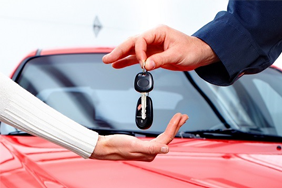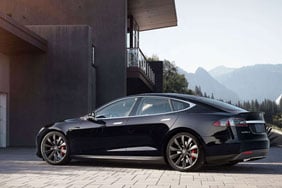Vehicle telematics is a technology that monitors and collects data on the driving habits of whoever's behind the wheel.
It tracks the driver's speed, plus other aspects of their driving behaviour, like their mileage or how they use the brake.
It's particularly popular for fleets of vehicles, where businesses want real-time data on the vehicle. This includes:
- Safety metrics
- Vehicle diagnostics
- Potential vehicle faults
- The vehicle's location
One study by Arval showed that 44% of UK fleets use telematics solutions - double that of those in Europe.
While telematics is used a lot for fleet management, consumer adoption is much lower. With personal vehicle telematics, drivers agree to have devices installed that directly communicate with insurers, usually in exchange for lower costs.
But today, the industry is changing, and vehicle telematics as we know it is evolving. Cars are becoming increasingly connected, with native computers that collect telematic information automatically.
As such, it's easy to see how installed vehicle telematics as a distinct technology may become less relevant.
So, what's the state of the industry today? And what's the future? Read on to find out.
How does telematics work and what's it used for?
Vehicle telematics systems use communication devices to monitor specific driver and vehicle characteristics.
It's been around since the 1960s. This was when technologies like the Global Positioning System (GPS) were first developed, and commercial vehicles started installing devices to monitor how often drivers would rest.
The technology has come a long way since then, and usually takes one of 3 forms:
-
Hard install, where the telematics are physically wired into the electronics of a vehicle, requiring professional installation. Connected cars are where a manufacturer has systems built into the car where data can be shared by themselves or other businesses.
-
Soft install is the most common option, where the insurer installs a 'black box'. This is usually in the form of a tag stuck onto the windscreen or dashboard (and sometimes plugged into the OBDII port). This is gyro and GPS sensors, often uploading data through the driver's phone and sending it to their insurer.
-
A mobile app that tracks driving data remotely. In 2012, Confused.com was one of the first companies to launch such an app, known as MotorMate.
Whichever solution vehicles use, they collect more or less the same information:
- Driving speed
- Location data
- Mileage
- How often drivers take breaks
- Any harsh braking
- Vehicle idling
- The times of day they typically drive
Plus, if there's an accident, the telematics devices will store information on what happened - including the collision speed - and send it to insurers.
Unlike traditional telematics, connected vehicles are vehicles whose pre-built onboard computer collects information about the car and the driver. These connected vehicles can then share this information. Some vehicles even collect data from onboard computers or Light Detection and Ranging (LIDAR) systems and can recreate the scene of an accident.
Connected vehicles are advancing fast, and can now pick up all sorts of data points, from engine issues to driver heartbeats and if people are wearing seatbelts.
Now, regardless of whether it's traditional telematics or connected cars, there's a glaring issue for many customers: privacy.
Research by GlobalData found that a third of people under 30 were concerned about having their vehicle directly connected to insurers, who can see all this information.
So, why do people choose insurance with telematics?
The uses of vehicle telematics
The main reason people use telematics in private vehicles - despite the privacy concerns - is cost. Customers using telematics tend to get lower insurance costs.
Yet, there are other motivations for using telematics.
When it comes to vehicle fleet telematics, businesses say there are 3 main reasons why they use it, according to Arval.
Firstly, businesses use it to improve driver safety and behaviour, for example, to ensure drivers aren't breaking any rules.
Secondly, they use it to improve security and locate their vehicles, which is particularly important if there's an accident or theft.
Finally, consumers use telematics to reduce costs and improve efficiency, which is possible through route optimisations, managing fuel costs, or cutting emissions.
That said, it's still the cost savings in insurance that likely motivates most drivers.
When an insurer installs telematics in a vehicle, insurers get access to all that real-time data on speed and driving habits. They consider telematics data alongside traditional risk factors, such as the driver's age, the type of vehicle, or the area the driver lives in. And ultimately, safe drivers are offered a discount.
Traditional telematics or 'black box' insurance is most popular among younger drivers, who may otherwise struggle to find affordable insurance. While telematics is only 6% of the market, Confused.com data shows 63% of customers are under 25.
There are other ways customers can benefit from telematics. For connected vehicles, in-built telematics can give you information about the health of your car and whether you need to do some vehicle maintenance. Or, if the vehicle gets stolen, you can locate it through the vehicle tracking feature using GPS.
There are commercial benefits too. One example is how some connected cars can offer rewards to drivers based on their vehicle location or where they've driven in the past. For instance, as people drive past a McDonald's or Starbucks, their vehicle can serve them a relevant voucher.
For drivers, using vehicle telematics has always been a toss-up between privacy and cost, or data confidentiality and convenience. And as connected cars collect ever more data, that tension is unlikely to disappear.
What are the benefits and drawbacks for insurers?
Vehicle telematics gives insurers greater control over pricing and insurance claims. Here are a few ways how:
- Telematics allows insurers to adjust the price of insurance to reflect driving habits and, therefore, improve risk assessments. For instance, if a customer drives often at night, the insurer can adjust the pricing accordingly.
- It means they can price more competitively for safer drivers. Using telematics, insurers can identify who drives responsibly and reward them for that (through cashback, or free giveaways)
- Telematics' crash detection lets insurers respond more quickly to incidents and better control claims. This means they don't need to wait until their customers inform them of the incident. For instance, this allows insurers to ensure customers use their preferred courtesy car provider or their preferred mechanic.
- Connected cars show how the accident happened. It's a data-driven way for insurers to understand who was at fault in an accident and why.
And what are the drawbacks?
More data isn't just an automatic plus for insurers or any other company. Instead, using data comes with its own obligations, responsibilities and costs.
- Telematics can be logistically expensive. The cost to install telematics is included in the insurance premium, driving up insurance costs for consumers. These devices can't always be reused, as they're often lost or left with ex-customers.
- Insurers need to have the infrastructure for the correct data storage and analysis. GDPR rules mean that insurers need to provide they're managing data effectively, to protect consumers' privacy. For example, when someone other than the policyholder is driving the car, the driver needs to permit the user to use their data. This can lead to an increase in admin costs for insurers.
- Each of the devices has its pros and cons. Different devices have different sensitivity levels, and the insurer must get them configured for each specific vehicle. This can be time-consuming. Hard installs, in particular, can be costly - as they require an install into the electronics of the vehicle.
Due to these drawbacks, it's not that surprising that telematics makes up a small part of the insurance market. But as we'll see, telematic features may soon be in almost every car.
What's the future of vehicle telematics technology?
Many industry analysts have predicted that connected vehicles will change the face of telematics.
I think they're right. According to Statista, vehicles with 'connected' capability will make up 100% of new car sales by 2026.
Connected vehicles are revolutionising the car industry in all sorts of ways, with a range of features, including entertainment offerings, vehicle-to-vehicle communication and enhanced security.
But to my mind, it's the data that these vehicles collect that will transform telematics.
Connected cars come with inbuilt sensors that track speed, location and driving habits - exactly like a convention 'black box' might. They add more data points and analysis, such as diagnostics - and even, as we saw earlier, characteristics like driver heart rates.
There are some important implications of this that insurance companies need to be aware of:
1. Telematics as we know it may no longer exist
Let's imagine the forecasts are correct, and all new vehicles sold after 2026 will be connected. In that case, telematics in its current form will become redundant.
For instance, new car drivers won't need a mobile app that tracks their driving behaviour. Similarly, insurers won't need to install vehicles with tag-style black boxes.
Instead, manufacturers will build telematics into the car itself. And that raises questions for insurers that they need to think about now.
For instance, if telematics is part of every new car, how can insurers access the data? And how will that change the relationship between manufacturers, insurers and consumers? For instance, will manufacturers sell their own insurance?
Of course, new cars won't make up all of the vehicles on the road by 2026. But the proportion of cars that need telematics devices (like black boxes) will only decline, affecting the insurance industry.
2. With or without telematics devices, car manufacturers will have access to more data
Back in 2014, McKinsey found that connected vehicles were already collecting as much as 25GB of data an hour.
Since then, car computers have only become more powerful and can collect more and more data.
The manufacturers collect that data, though - not the insurers. As we explore later, they may start offering insurance based on that data.
For insurers in general, though - manufacturers or conventional insurers - more data means more information that an insurer can use to calculate customer costs. Do high-stress levels, shown by erratic braking, increase the risk of an incident? Or do higher external temperatures affect the chance of a claim?
Proper utilisation of this data brings opportunities for personalised and better-informed deals beyond those possible with telematics that only provide speed and driving habits.
Of course, consumers have to be willing to accept this - and that's not a given. A survey from Parkers suggests that most drivers don't want connected cars to share their data with anyone.
The balance we've seen before in telematics - between privacy and personalisation - will continue to be an important discussion in the industry.
3. Original equipment manufacturer (OEM) insurance may be on the rise
As connected cars become more common, it won't be primarily insurers collecting driving data. Instead, it's the vehicle manufacturers themselves that will collect and store more of the information.
As a result, OEMs may themselves offer tailored insurance deals to their customers, leveraging all that data.
That's already happening. For instance, Tesla - the creator of one of the 'smartest' connected cars - has already launched its own insurance offering.
And when connected cars have the clearest insight into driver behaviour, other OEMs may well follow suit.
That possibility poses difficult questions for insurance companies, with new potential challengers disrupting the sector. However, it's not certain that this will happen.
For example, I think it's unlikely that purely embedded insurance - where customers buy insurance with the original product - will be acceptable to regulators or the Competitions & Markets Authority (CMA).
Instead, insurers may have to request access to that data from manufacturers.
4. A debate is on the horizon about who owns vehicle data
Currently, the law states that customers legally own their data. This means drivers own the data on their driving habits, too.
However, not everyone agrees - and it's likely that consensus may fray further in the future. For instance, according to a survey by KPMG, almost half of consumers believe they should own their driving data. But this opinion isn't shared among executives from the automotive industry.
The survey found that just 35% of UK auto executives expect the driver or car owner to have ownership over the data their vehicles collect in the future.
Still, everyone will need to abide by privacy laws. But that aside, plenty of other issues need to be ironed out.
Clearly, there are still a lot of questions to be answered on the topic of vehicle data privacy.
The role of Confused.com
Over the years, Confused.com has played an important role in vehicle telematics insurance. For instance, we were one of the first companies to introduce automotive telematics via a mobile app with MotorMate back in 2012.
Since then, we've offered customers telematics insurance to help them lower their premiums.
If OEMs begin to offer their own insurance and telematics becomes widespread, a different question will arise. How do we ensure customers can accurately compare car insurance from different providers?
I think there's no reason why conventional insurers couldn't access vehicle data, even if OEMs offer their own services. And at the same time, there's no reason why price comparison websites (PCWs) couldn't continue to offer competing deals using this information.
At Confused.com it's our role to maintain competition in the market so we can allow customers to compare their manufacturer insurance to other deals. For instance, if vehicle manufacturers such as Tesla were to join our panel, we could offer their OEM insurance, among other results.
Ultimately, at Confused.com, we're the consumer champion - and data on driving behaviour still legally belongs to the customer. Even if a connected car collects that data, consumers should be able to choose which insurer they prefer.
As such, PCWs like Confused.com will remain relevant, as we're still the preferred option among customers for finding the best insurance deals.
Vehicle telematics is changing, but it will play a big role in the future of car insurance
Automotive telematics, as we know it, likely has an expiration date.
With the exception of vehicle fleet operators, telematics hasn't been a huge part of the insurance industry. But, as connected vehicles become the norm, this will likely change - though in a different form.
Rather than the black boxes we're used to, connected cars will collect data through their in-built hardware. They're doing it already.
And so, the main question for insurers is: When OEMs start offering their own insurance, how can insurers differentiate and deliver a better product?
Stay in the loop about how the industry is adapting and learn more about what we do at Confused.com.







